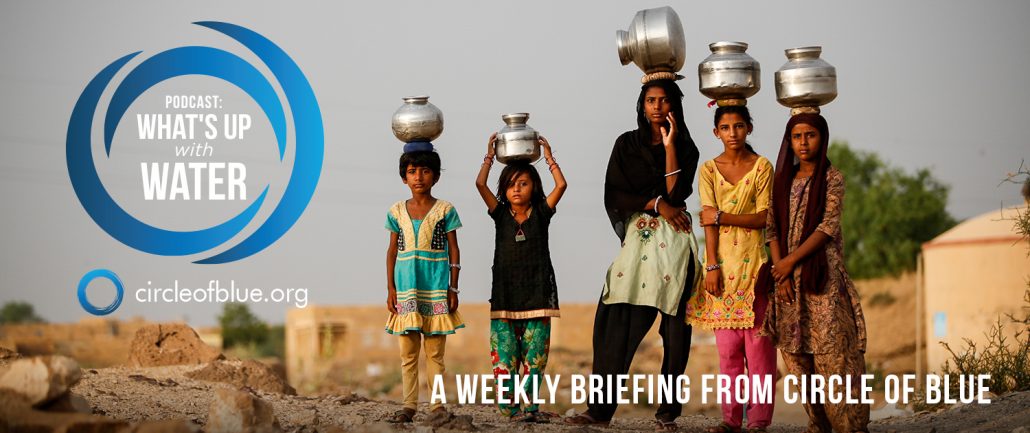
Transcripts
What’s Up With Water for April 30, 2018
I’m Eileen Wray-McCann, for Circle of Blue, and here’s What’s up with Water, a condensation of the world’s water news.
To preserve drinking water, Cape Town officials are cracking down on illegal uses. For the last four months, the city’s law enforcement department has patrolled the streets, looking for people who are washing cars or watering gardens with tap water…and therefore violating the city bylaws. Wayne Dyason, a principal inspector, told Circle of Blue’s Brett Walton that the patrols have led to arguments about the value of certain water uses.
Dyason says that though people argue against the fines, officers are diligent in applying the law.
Walton’s Cape Town reporting is supported by a grant from the Pulitzer Center on Crisis Reporting.
Cape Town may have avoided Day Zero for 2018, but in many parts of India, the day when the water taps run dry isn’t a prediction – it arrived long ago.
The UK-based charity group WaterAid reports that nearly 163 million people in India, more than one in ten in the country, have no near access to clean water.
India’s groundwater is increasingly depleted by population growth, agriculture, industry, poor water management and rising temperatures. Adding to the stress are geopolitical pressures over water rights with neighboring Bangladesh, Pakistan, and China. A South Asia Expert at the Wilson Center, a policy think tank in Washington, described the situation as “a perfect storm for greater water insecurity.”
Most of India’s cities lose a significant percentage of their water to leakage or theft. Wastewater is underutilized. India is one of the world’s largest groundwater users, with subsidies that encourage farmers to run their electric irrigation pumps more than necessary, and lax policy on water extraction.
The Center for Science and the Environment said that “Day Zeros are inevitable unless cities push for judicious use of water – including rainwater harvesting and reuse of wastewater, as well as more efficient irrigation, and regulation of tube wells.”
Ethiopia is preparing to fill the reservoir behind its new Grand Renaissance Dam, built on a tributary of the Nile. The $4 billion dollar project may start receiving water as soon as this year, and the effects on Egypt could be immense, depending on how fast the reservoir is filled.
Farmers downstream in the Nile Delta rely on the river for crop irrigation that feeds Egypt’s growing population.
President Abdel Fattah al-Sisi has put Egypt’s claim to the Nile at the top of his agenda. And authorities are enforcing long-ignored restrictions on growing water-intensive rice. Traders say it’s likely that next year Egypt will have to import rice, instead of being a major exporter.
An Egyptian official said the Ethiopian dam has opened the door for more awareness of water scarcity, and that Egypt has long needed to review its water allocation policy.
Egypt identifies with the Nile, but the river and its tributaries flow through ten countries. Sudan and Egypt are the foremost users in terms of irrigation and dams, and have tried to negotiate a water-sharing agreement with each other for years. With the dam, Ethiopia is now a player at the table. It intends to become Africa’s largest power source, bringing electricity to tens of millions of people for the first time. Egypt, Sudan and Ethiopia began talks earlier this month, but they stalled over technical issues.
Egypt wants assurances that the dam will not affect the flow of the Nile, but that depends on how fast Ethiopia fills the reservoir. Ethiopia wants to do it in as little as three years while Egypt is advocating seven to ten years. One expert suggests that the three-year plan could destroy 51 percent of Egypt’s farmland.
The United Nations Food and Agriculture Organization called for an “urgent and massive” response for Egypt’s food security. An Egyptian irrigation minister told Reuters news service that the situation is threatening crops, livelihoods and political stability.
In Pakistan, officials hope to transform the small fishing port of Gwadar into a duty-free economic zone, making it “the next Dubai.” Gwadar has a strategic location on the Arabian Sea, close to Iran and the mouth of the Persian Gulf. The plan, over a decade in the making, is to bolster Pakistan’s economy with a regional commercial, industrial and shipping hub. It’s part of a project called the China Pakistan Economic Corridor, designed to provide China with a shorter and more secure trading route to the Middle East and outward.
The snag is that, like Dubai, Gwadar is very dry. It hasn’t rained there for three years now, and climate change is being blamed. The neighboring reservoir is empty and water must come by tankers a two-hour drive away. A local authority said that demand for water was over three times the amount supplied. Some residents are critical of the government’s plans to turn a fishing port into an international economic zone. They want water, medical care, electricity and garbage service first.
Two desalination plants in [GWAD-are] Gwadar convert brackish groundwater into fresh water, and another large plant is scheduled to come online in July. More doctors, new roads, an airport, and a power plant are all intended to win over the locals and attract visitors to the dream of Dubai in Pakistan.
In the United States, an interstate agreement to protect the Great Lakes is being put to the test. Wisconsin regulators approved a proposal from the city of Racine to divert Lake Michigan water to a neighboring town for industrial use. Mt. Pleasant, inland from Racine, is the site for a huge factory that will produce liquid crystal display panels for Foxconn Technology Group, a multinational company headquartered in Taiwan. Last week, the same day that the Wisconsin Department of Natural Resources gave its approval, Foxconn said it would soon announce construction plans for the plant, expected to employ up to 13,000 people.
Environmentalists suggest that they might challenge the DNR approval, saying that it violates the Great Lakes Compact, which governs how to use water from the lakes. They say that the diversion to Mt. Pleasant is not for public purposes, which is required by the compact and state law.
The Wisconsin DNR allowed Racine to divert an average of 7 million gallons a day. The city says that nearly 6 million gallons would be used by the Foxconn plant. Environmentalists note that nearly 3 million gallons per day will not be returned to the Great Lakes basin, lost mostly due to evaporation.
The DNR says that loss is within the threshold that the compact allows without approval by the Great Lakes states and provinces. The DNR added that the new diversion would only be a .07 percent increase in the total surface water withdrawals from Lake Michigan.
Wisconsin Governor Scott Walker has promoted the $10 billion dollar plant, which will get about $4 billion from state and local taxpayers, most in the form of incentives negotiated by Gov. Walker.
Foxconn pledges to integrate green and sustainable practices, but environmentalists and residents are concerned about the lack of state oversight on the environmental impacts of the plant.
And that’s What’s Up With Water…We’d like to share what’s up where you are – Tweet us with your water news: @circleofblue #whatsupwithwater.
Eileen Wray-McCann is a writer, director and narrator who co-founded Circle of Blue. During her 13 years at Interlochen Public Radio, a National Public Radio affiliate in Northern Michigan, Eileen produced and hosted regional and national programming. She’s won Telly Awards for her scriptwriting and documentary work, and her work with Circle of Blue follows many years of independent multimedia journalistic projects and a life-long love of the Great Lakes. She holds a BA and MA radio and television from the University of Detroit. Eileen is currently moonlighting as an audio archivist and enjoys traveling through time via sound.



